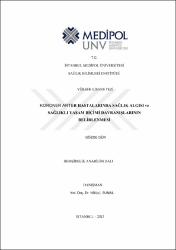| dc.contributor.advisor | Sunal, Nihal | |
| dc.contributor.author | Gür, Gözde | |
| dc.date.accessioned | 2021-06-07T08:31:12Z | |
| dc.date.available | 2021-06-07T08:31:12Z | |
| dc.date.issued | 2017 | en_US |
| dc.date.submitted | 2017-08-11 | |
| dc.identifier.citation | Gür, G. (2017). Koroner arter hastalarında sağlık algısı ve sağlıklı yaşam biçimi davranışlarının belirlenmesi. (Yayınlanmamış yüksek lisans tezi). İstanbul Medipol Üniversitesi Sağlık Bilimleri Enstitüsü, İstanbul. | en_US |
| dc.identifier.uri | https://hdl.handle.net/20.500.12511/7055 | |
| dc.description.abstract | Bu araştırma koroner arter hastalarında sağlık algısı ve sağlıklı yaşam biçimi davranışlarının belirlenmesi amacıyla tanımlayıcı olarak yapılmıştır. Araştırmanın örneklemini İstanbul Medipol Mega Hastaneler Kompleksi KYBÜ'ndeMayıs 2016 - Ocak 2017 tarihleri arasındaKAH tanısı almış, PKG uygulanmış, çalışmaya katılmayı gönüllü olarak kabul eden ve sorulara eksiksiz cevap veren 305 hasta oluşturmuştur. Çalışma verileri hastalarla yüz yüze görüşülerek 'Sosyodemografik Bilgi Formu' 'Sağlık Algısı Ölçeği' ve 'Sağlıklı Yaşam Biçimi Davranışları Ölçeği' kullanılarak elde edilmiştir. Elde edilen verilerin değerlendirilmesinde sayı, yüzde, ortalama, Cronbach alfa katsayısı, Kolmogorov-Smirnov, Mann Whitney U testi, Kruskal Wallis testi kullanılmıştır.Katılımcıların yaş ortalaması 58,63 ± 11,08 olup, %32,5'inin 55-64 yaş grubunda (n=99) olduğu saptanmıştır. Ayrıca %63,3'ünün erkek (n=193), %84,6'sının (n=258) evli, %48,5'inin ilköğretim mezunu (n=148) olduğu görülmüştür. Katılımcıların SAÖ'den aldıkları puan ortalamasının 47,37±5,77, SYBDÖ'den aldıkları puan ortalamasının 131,36±26,71 olduğu belirlenmiştir.SAÖ ile SYBDÖ ve alt boyutlarının puan ortalamaları arasındaki ilişki Spearman korelasyon analizi ile incelendiğinde; SAÖ ile SYBDÖ'den alınan puan ortalamaları arasında zayıf derecede pozitif ilişki saptanmıştır (r=-0,403; p=0,000). Çalışmadan elde edilen sonuçlar doğrultusunda; KAH'sı olmak hastaların çoğunu yaşam tarzını değiştirmeye itse de bunun ağırlıklı olarak doktor kontrolüne düzenli gitmek ve ilaçlarını düzenli kullanmak yönünde hastaları motive ettiği, diyet, egzersiz gb gerçek yaşam tarzı değişiklikleri sorgulandığın da ise bu yöndeki çabalarının yetersiz olduğu görüldü. SYBDÖ skorlarının hem sosyodemografik parametreler hem yaşam tarzı değişiklikleri hem de alışkanlıklar ile daha körele olduğu saptandı. Dolayısıyla bu ölçeğe göre daha düşük puanlar alan bireylere daha çok zaman ayrılarak sağlıklı yaşamın tüm boyutlarının hayata geçirilmesi konusunda gerekli eğitim ve danışmanlığın verilmesi gerekmektedir. | en_US |
| dc.description.abstract | The purpose of our descriptive study is to determine the perception of health and healthy lifestyle behaviors in patients with coronary artery disease (CAD). The study sample consisted of 305 patients treated in the coronary care unit of the Istanbul Medipol Mega Hospital Complex between May 2016–January 2017, who were diagnosed as having coronary artery disease, treated with percutaneous coronary intervention, willing to participate in the study, and able to completely answer the study questionnaires. Study data was obtained by using the "Sociodemographic Information Form", "Perception of Health Scale (PHS)", and "Healthy Lifestyle Behaviour Scale (HLBS)" by direct communication with the participants. The statistical methods included number, percentage, mean, Cronbach alfa coefficient, Kolmogorov-Smirnov, Mann Whitney U, and Kruskal Wallis tests. The participants had a mean age of 58.63 ± 11.08 with a male dominance of 63.3% (n=193). Ninety-nine patients (32.5%) appeared to be between ages of 55 – 64. The marriage percentage of the population was %84.6 and a total of 148 patients (48.5%) had an education level of elementary school. The mean score of the PHS was 47.37 ± 5.77 and the mean score of HLBS was 131,36 ± 26,71. Spearman correlation was used to analyze the relation between mean scores of the PHS and the HLBS. There was a relatively weak association between the mean PHS and the HLBS scores (r=-0,403; p=0,001). The results of the study showed that having CAD seemed to motivate the patients to change their lifestyle, mostly by regular doctor visits and adherence to treatment. However, real lifestyle changes such as dietary modification and exercise were seemed to appear inadequate among the participants. HLBS scores were more likely to be correlated with both sociodemographic parameters, lifestyle changes and behaviors. The results of our study showed that patients with low HLBS scores should be more closely followed for appropriate education and counseling to improve health outcomes. | en_US |
| dc.language.iso | tur | en_US |
| dc.publisher | İstanbul Medipol Üniversitesi Sağlık Bilimleri Enstitüsü | en_US |
| dc.rights | info:eu-repo/semantics/openAccess | en_US |
| dc.subject | Hemşirelik | en_US |
| dc.subject | Koroner Arter Hastalığı | en_US |
| dc.subject | Perkütan Koroner Girişim | en_US |
| dc.subject | Sağlıklı Yaşam Biçimi Davranışları Ölçeği | en_US |
| dc.subject | Sağlık Algısı Ölçeği | en_US |
| dc.subject | Coronary Artery Disease | en_US |
| dc.subject | Healthy Lifestyle Behaviour Scale | en_US |
| dc.subject | Nursery | en_US |
| dc.subject | Percutaneous Coronary Intervention | en_US |
| dc.subject | Perception of Health Scale | en_US |
| dc.title | Koroner arter hastalarında sağlık algısı ve sağlıklı yaşam biçimi davranışlarının belirlenmesi | en_US |
| dc.title.alternative | Determination of health perception and healthy lifestyle behaviors in patients with coronary artery disease | en_US |
| dc.type | masterThesis | en_US |
| dc.department | İstanbul Medipol Üniversitesi, Sağlık Bilimleri Enstitüsü, Hemşirelik Ana Bilim Dalı | en_US |
| dc.relation.publicationcategory | Tez | en_US |


















